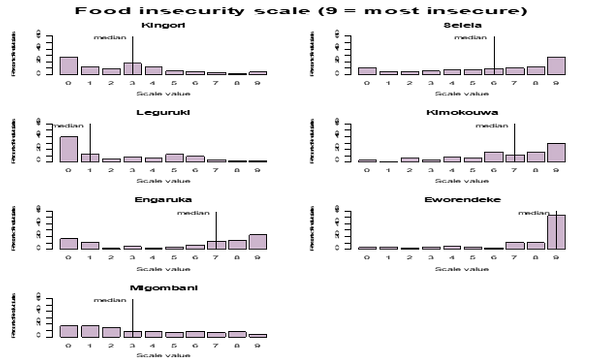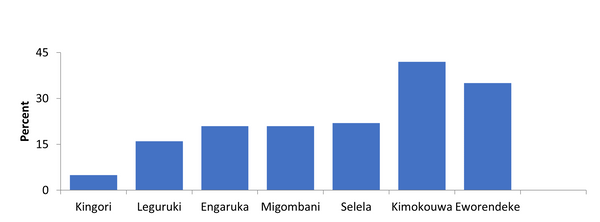This article summarizes research by Savannas Forever, conducted on behalf of Canadian Foodgrains Bank and Global Service Corps. East Africa’s Director in his previous job with Global Service Corps helped contract Savannas Forever to do the survey. Findings are shared with permission from Susan James, Director of Savannas Forever.
World population and food supply are increasingly major concerns, especially in Africa. U.N. statistics confirm the extent of challenges ahead:
- There is a 40% malnourished population in SSA: it is higher in pastoralist areas;
- The global population will increase by 50% by 2050: it is higher in pastoralist areas;
- In SSA the population will increase by 150% over the next 80 years;
- This increase will require 70% more food globally; (note: Africa’s per capita food production has been declining over the last 40 years, and even more so in pastoralist areas);
- Worldwide hunger has decreased in the last 40 years to just less than 10%, but it hovers around 20% in SSA (UNICEF 2020). It exceeds 40% in pastoralist areas.
Measuring Hunger and Targeting Those In Need
When I (the author) joined ECHO in 2012 I had just worked on a project disseminating food security initiatives in 48 villages in northern Tanzania. We commissioned a baseline study of 7 villages by Savannas Forever, a research engine connected with the University of Minnesota. We discovered some stark realities facing pastoralist communities.
Pastoralists were by far less food secure than agro-pastoralist communities and agricultural communities.
The study clustered the seven villages into two groups:
[a] predominantly agricultural livelihoods with access to water, higher food security, more prosperity, and more educated.
[b] predominately pastoralist livelihoods, located in drier microclimates, poorer nutrition indicators, lower food security, and suffering more severe livestock losses during droughts which had been more frequent in the past decade.
To measure food insecurity, a nine-question tool was used, developed by the FAO [http://edn.link/ean10fao]. Respondents were asked questions about household food availability during the previous four weeks.
The questions covered nine food insecurity scenarios, ranging from mild forms of food insecurity in the household to those implying severe food shortage. A score of “9” indicated a severe household food insecurity score.
Do you want to take the food insecurity test? Here it is:
In the past four weeks…
- did you worry that your household would not have enough food?
0 = No; 1 = Yes - was any household member not able to eat the kinds of foods preferred because of a lack of resources?
0 = No; 1 = Yes - did any household member have to eat a limited variety of foods due to a lack of resources?
0 = No; 1 = Yes - did household members have to eat some foods that not wanted to eat because of a lack of resources to obtain other types of food?
0 = No; 1 = Yes - did any household member have to eat a smaller meal than needed because there was not enough food?
0 = No; 1 = Yes - did any household member have to eat fewer meals in a day because there was not enough food?
0 = No; 1 = Yes - was there ever no food to eat of any kind in your household because of a lack of resources to get food?
0 = No; 1 = Yes - did any household member go to sleep at night hungry because there was not enough food?
0 = No; 1 = Yes - did any household member go a whole day and night without eating anything because there was not enough food?
0 = No; 1 = Yes
The results of the study showed:
- Food security is better in the villages with greater access to water and which have been less hard hit by drought.
- Having large numbers of larger livestock (cattle, sheep, goats) had NO impact on food security. However, having poultry was the only positive correlation between livestock and food security: households that had chickens had higher food security than those without.
- Female-headed households in the first seven villages have substantially higher food insecurity levels (average scale value 6.0) than households headed by men (average 4.3).
- In longitudinal data, comparing 2006 to 2009, the number of female-headed households increased significantly in pastoralist villages, as did their food insecurity. As an explanation, these livestock keepers were hard hit by drought and livestock losses. Many men left to find work in cities or moved their cattle to another pastureland.

Figure 4. Food insecurity results for seven villages. Source: Susan James
The food insecurity comparison shown in graph form demonstrates the stark differences among three clusters of villages,
- predominantly agricultural villages (King’ori, Leguruki, Migombani),
- pastoralist villages that had some irrigated agriculture (Engaruka, Selela), and
- pastoralist villages without irrigation (Kimokouwa, Eworendeke)
Significant differences were also noted in the percentage of female-headed households compared to male-headed households across the predominantly farming, mixed, and pastoralist communities:

Figure 5. Percentage of female-headed households across communities surveyed. Source: Susan James
The need for hunger organizations to focus on pastoralists
ECHO’s concern is to reduce hunger and improve the lives of the poor in East Africa. We must work with and support those who work with the hungry in all communities, but, especially in the drylands.
The agro-pastoralists and pastoralists are the most vulnerable population groups in the region. The other vulnerable population groups are women-headed households, maternal mothers, babies, youth especially girls, unwed mothers, the urban poor, the jobless, and the homeless. These persons often have the least access to land with minimal roles in the decision-making of family assets. Effective solutions will be low-cost and low-input. They must maximize self-reliance and consider gender.
Making alleviation of hunger sustainable
ECHO East Africa encourages collaboration among other NGOs through periodic symposia and the ECHO network. By accessing www.echocommunity.org, one will find a robust list of resources to impact households. Many resources confirm the findings described above. Numerous options can be searched on the ECHO website for more details as interventions. They are deemed by ECHO EA staff to be among the most impactful ways to sustainably alleviate hunger and the drudgery of rural pastoralist lives
What are some of the most impactful ways to sustainably alleviate hunger?
ECHO EA encourages gatherings to gain the experiences of other NGOs at symposia and through our network. If you go online at www.echocommunity.org, you can access a robust list of resources to impact households, and many align with the findings described above.
For example, the following nine options can be searched on our website for more details as interventions. They are deemed by ECHO EA staff to be among the most impactful ways to sustainably alleviate hunger and the drudgery of rural pastoralist lives